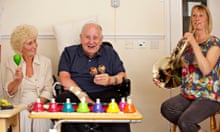Ron Abbott, 85, is sitting on a bench in the courtyard garden of a Sheffield hospital with what looks like a baby seal on his knee. He is looking into its eyes, lost in a world, then he brushes its whiskers and tickles its nose with a slow finger. "Itchy-itchy-itchy-coo," he says. The seal wriggles, gazes back at him and makes small, seal-like noises. Abbott's smile shows his pleasure.
Beside him is Claire Jepson, an occcupational therapist at The Grange, an NHS specialist assessment unit for dementia patients.
One of the biggest challenges staff face during the four- to eight-week assessment period is managing distressed and disturbed behaviour. Medication is one recourse. Paro is another.
Paro is a robot seal, modelled unashamedly on a baby harp seal, both in terms of looks and the plaintive cry that it makes. Its Japanese creater, Takanori Shibata, chose it because people are unlikely to have unhelpful memories of real seals. It also mitigates against the charge that vulnerable people are being deceived into believing that this is a real animal, that this cute cartoon of a creature is anything other than synthetics and circuitry, and not flesh and blood.
Paro has some artificial intelligence. It has the ability to "learn" and remember its own name, and it can learn the behaviour that results in a pleasing stroking response and repeat it. Paro is not new – the robot has been around since 2004, which in terms of robotics makes it ancient history. But clinically, that is what makes it so interesting – Paro has been around long enough to give some idea of whether or not it actually works. Which is why the effectiveness of the robotic seal in a dementia care setting is now being evaluated in a joint project involving Sheffield Health and Social Care NHS Foundation Trust and the University of Sheffield.
"My perspective is that anything that makes people feel comforted and more at ease with the world is worth it when people are in the later stages of dementia," says Gail Mountain, professor of health service research at the university of Sheffield.
With dementia affecting 800,000 people in the UK and numbers set to double over 20 years, the Grange introduced Paro last year. There are some 3,000 Paro seals worldwide, the vast majority in Japan where they have even been used to befriend earthquake survivors. There are around 10 in the UK; two of which are at the Grange.
"When I first saw Paro on YouTube I thought it was very twee," says Jepson, as she prepares to give me a demonstration. We are in a quiet rest area of the ward and the seal sits on the table between us, inanimate, eyes closed, looking like a child's cuddly toy. But once it is switched on, it is clearly not a toy. Its eyes are surprisingly affecting, and as it moves and responds to your touch there is a musculature apparent in its face that conspires to give it a real "living" feel.
Pick it up and it is a surprisingly hefty bit of kit. On your knee you know it is there, and weighing 3kg it feels comparable to a dog of a similar size. This weight gives it a gravitas, and as it waddles and flaps its flippers as you stroke it, the whole thing vibrates.
Jepson uses Paro to encourage social behaviour, she explains. "There is a lot of humour with Paro. Many of the patients anthropomorphise the seal, enjoy pretending that it is a real, living creature, with all the associated foibles. As well as the nurturing: 'Let's look after it and stop it crying', a lot of people refer to its bodily functions," says Jepson. "They'll say [as a joke]: 'Oh it's farted on me!' or 'Don't you go peeing on my leg!' and then people will laugh, and the jokes will come in, and it creates a nice social interaction." Encouraging social interaction and calming distressed patients are proving to be two of Paro's most promising uses.
Jepson uses it in structured therapeutic sessions and admits that she has "fallen for this fabulous bit of kit".
"It is a robot companion. It is about empowerment," she says. "It allows people to still feel a sense of achievement, a sense of identity. They become the carer instead of the cared for."
The use of companion robots and assistive technology in care for older people is in its infancy. Toyota, for example, is experimenting with assistive robots that can lift and carry patients to alleviate risks for carers. But they are not without controversy. Two concerns are that users are deceived, believing that the robot is real, and that it infantalises them, demeaning patients' dignity.
At the Grange, Abbott seemed convinced that the seal was real, but Pam, another dementia patient playing with the robot, was clearly aware that as seals go, it was a fraud.
With the government unveiling the UK's first official robotics strategy last week, which could lead to an increased use of robots in our everyday lives, Amanda Sharkey, a senior lecturer in Sheffield University's department of computer science, warns: "I think we need to be a bit careful about human interactions with robots, so we don't end up with old people being looked after by robots and nothing else. So I think you could misuse Paro in the sense of: we've given this old lady the seal to look after and now we don't have to go and talk to her."
Initial results of the research are due out next month. Mountain would like to place Paros in more dementia care environments. But as each Paro costs £4,000, including a day's training, funding is vital.
Abbott's daughter, Sarah O'Neill, 43, believes that if tools such as Paro can help people with dementia to find some peace then they should be used.
"Some people may think, 'Oh, he is playing with a doll and that isn't really what an adult should do', but they have lost so much of the core of what makes them a 'grown-up' adult, I don't really think that should be applied," says O'Neill.
"Basically, when you see someone in such a distressing state, it is horrible for you and it is horrible for them. Who knows what is happening in Dad's brain chemistry? But if anything can just stop that for a moment and make him smile, or laugh, then brilliant."











Comments (…)
Sign in or create your Guardian account to join the discussion